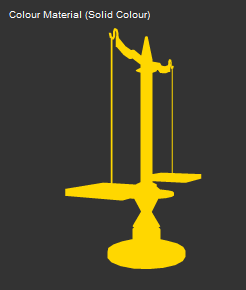Archive for March, 2009
This Part of the Shaders Tutorial series will show you how to add Flat shader material to either a dae imported object or to a basic primitive.
If you are a novice, it is advised that you follow this tutorial from the initial section that can be found here, which explains how to set up the files and the scene. Otherwise please read on.
For those following on the shaders tutorial series, i will be calling this .as file flatMat
to begin with we must begin the package and import the relevant classes
package flatMat {
import flash.display.Sprite;
import flash.events.Event;
import flash.text.TextField;
import flash.text.TextFormat;
import org.papervision3d.cameras.CameraType;
import org.papervision3d.lights.PointLight3D;
import org.papervision3d.materials.shadematerials.FlatShadeMaterial;
import org.papervision3d.materials.shadematerials.CellMaterial;
import org.papervision3d.materials.utils.MaterialsList;
import org.papervision3d.objects.primitives.Sphere;
import org.papervision3d.render.BasicRenderEngine;
import org.papervision3d.view.BasicView;
import org.papervision3d.objects.parsers.DAE;
import org.papervision3d.objects.DisplayObject3D;
now we must begin the class, and add the variables that we will be using
This Part of the Shaders Tutorial series will show you how to add Cell shader to either a dae imported object or to a basic primitive.
If you are a novice, it is advised that you follow this tutorial from the initial section that can be found here, which explains how to set up the files and the scene. Otherwise please read on.
For those following on the shaders tutorial series, i will be calling this .as file cellMat
package cellMat{
we then need to import our classes
import flash.display.Sprite;
import flash.events.Event;
import flash.text.TextField;
import flash.text.TextFormat;
import org.papervision3d.cameras.CameraType;
import org.papervision3d.lights.PointLight3D;
import org.papervision3d.materials.shadematerials.CellMaterial;
import org.papervision3d.materials.utils.MaterialsList;
import org.papervision3d.objects.primitives.Sphere;
import org.papervision3d.render.BasicRenderEngine;
import org.papervision3d.view.BasicView;
import org.papervision3d.objects.parsers.DAE;
import org.papervision3d.objects.DisplayObject3D;
now we must initiate our class, and set our variables
public class cellMat extends Sprite
{
private var view:BasicView;
private var cell:CellMaterial;
private var light:PointLight3D;
private var sphere:Sphere;
private var angle:Number = new Number(0);
private var tf:TextField;
private var format:TextFormat;
private var dae:DAE;
private var daeFile:String;
private var daeMaterialName:String;
I am happy to say, that this blog has been nominated for the category of “Best Educational Blog”, in the Bloggers Choice Awards 2009.
If you like this blog, please take some time to vote! your count is appreciated!
This Part of the Shaders Tutorial series will show you how to add colorMaterial shader to either a dae imported object or to a basic primitive.

Colour Material Shader Example
If you are a novice, it is advised that you follow this tutorial from the initial section that can be found here, which explains how to set up the files and the scene. Otherwise please read on.
This code is pretty basic / self explanatory, so I will not be explaining much about it. If you do require any help, just post a comment below.
package colorMat {
import flash.display.Sprite;
import flash.events.Event;
import flash.text.TextField;
import flash.text.TextFormat;
import org.papervision3d.cameras.CameraType;
import org.papervision3d.materials.ColorMaterial;
import org.papervision3d.materials.utils.MaterialsList;
import org.papervision3d.objects.primitives.Sphere;
import org.papervision3d.render.BasicRenderEngine;
import org.papervision3d.view.BasicView;
import org.papervision3d.objects.parsers.DAE;
import org.papervision3d.objects.DisplayObject3D;
public class colorMat extends Sprite
{
private var view:BasicView;
private var color:ColorMaterial;
private var sphere:Sphere;
private var tf:TextField;
private var format:TextFormat;
private var dae:DAE;
private var daeFile:String;
private var daeMaterialName:String;
This Part of the Shaders Tutorial series will show you how to add an Environmental Material Shader to your objects.
What this basically does is take a texture imported from the background and use it to reflect off the object, giving the object a highly reflective coating which is faked. This keeps processing power down, while giving a nice effect.
For this tutorial we will be creating an effect that looks something like this: (please be patient while the video loads)
If you are a novice, it is advised that you follow this tutorial from the initial section that can be found here, which explains how to set up the files and the scene. Otherwise please read on.
To begin with, we must begin our new package and import our classes.
package environmentMat{
import flash.display.BitmapData;
import flash.display.Loader;
import flash.display.Sprite;
import flash.events.Event;
import flash.net.URLRequest;
import flash.text.TextField;
import flash.text.TextFormat;
import org.papervision3d.cameras.CameraType;
import org.papervision3d.lights.PointLight3D;
import org.papervision3d.materials.shadematerials.EnvMapMaterial;
import org.papervision3d.objects.primitives.Sphere;
import org.papervision3d.render.BasicRenderEngine;
import org.papervision3d.view.BasicView;
//
import org.papervision3d.objects.parsers.DAE;
import org.papervision3d.objects.DisplayObject3D;
//Ability to add materials
import org.papervision3d.materials.BitmapMaterial;
import org.papervision3d.materials.BitmapFileMaterial;
import org.papervision3d.materials.utils.MaterialsList;
Then initialise our class and create the variables that will be using
public class environmentMat extends Sprite {
private var view:BasicView;
private var img:Loader;
private var environment:EnvMapMaterial;
private var light:PointLight3D;
private var sphere:Sphere;
private var angle:Number = new Number(0);
private var tf:TextField;
private var format:TextFormat;
private var dae:DAE;
private var daeFile:String;
private var daeMaterialName:String;




